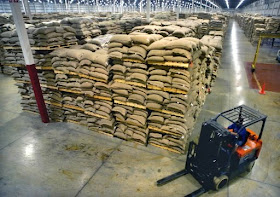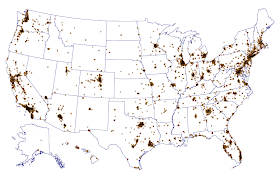
PRODUCT FLOW
Starbucks coffee uses an assembly line type of product flow they use. Assembly line flow is characterized by a linear sequence of operations. The product moves from one step to the next in a sequential manner from beginning to end. When a customer orders coffee, this product is made from one step to the next from beginning to end. A customer will specify the type of coffee he wants and it is made adding the ingredients in a systematic way.
 CUSTOMER ORDER PROCESS
CUSTOMER ORDER PROCESSStarbucks uses an Assemble to Order (ATO) process when helping customers. ATO is a hybrid or combination of Make to Order (MTO) and Make to Stock (MTS). Starbucks has the inventory in every branch to reach customer needs, but customers also have the option of personalizing it to their liking. For Instance, a person can order a non-fat latte or a frapuccino without whip cream. The product is made when a customer puts in their order yet all the materials are kept at hand for workers to make each order accordingly. Also, they keep certain things made at all times on hand like caffeinated and decaffeinated coffee because it’s a common order that’s expected to sell and can be customized for the specific customer such as adding sugar or milk if they’d like to.
PROCESS CHARACTERISTICS MATRIX
The process characteristics matrix has six possible combinations that a company can adopt. Starbucks' position on the matrix is Assembly line - Assemble to order. Even though every drink is customized to each customer, they follow the same process. This is done because all materials are made assembly line in bulk for Starbucks. Because of this the baristas are able to follow simple recipies to quickly push the product to the customers. This configuration is common in fast food.
 FACTORS INFLUENCING PROCESS SELECTION
FACTORS INFLUENCING PROCESS SELECTIONSome of the factors influencing the way that Starbucks does their process selection include market conditions; including what do customers want and in what quantities. Starbucks also takes into consideration what is offered by competitors like Dunkin Donuts. Customers might like some of our choices and some of theirs so it is up to Starbucks to make decisions with the given information. Capital requirements are another factor that influences Starbucks process selection; the actual monetary requirements to set up production. This is why it is important to know the amount of capital we have in Starbucks before making decisions like expanding or introducing a new product line. Availability and cost of labor is another factor influencing process selection. Since Starbucks employs different hourly employees at any of its stores, it is important that there are enough employees to run the place smoothly. Not only is the labor easily available but also is their employment cost efficient. Lastly state of technology is another factor influencing the process selection. Inventory is managed electronically and would not be possible if the right technology where not in place. Inventory management is one the keys to success of Starbucks because they can do it easily and also reducing their overhead costs.

ADOPTION OF MASS CUSTOMIZATION
Starbucks currently utilize two types of mass customization in the production of their beverages. One form is modular production - assemble to order process as the baristas assembles standardized components at the moment of sale for its customers. For example each customer’s coffee is customized specifically for them due to the fact that they choose the specific ingredients which are the standardized components such as milk, fat free milk, non dairy creamer, sugar, sweetener etc.
The second type of mass customization is Postponement which is the deferring of a portion of the production until the point of livery. For example standardized beverages such as frapuccinos is brewed and awaits the differing aspects such as whip cream, which is held back to be added at the point of sale.
 Inventory is described as “ a stock of materials used to facilitate products or satisfy customer demands.” Typical inventories include raw materials, works in progress and finished goods. (pg 363 of the text)
Inventory is described as “ a stock of materials used to facilitate products or satisfy customer demands.” Typical inventories include raw materials, works in progress and finished goods. (pg 363 of the text)





